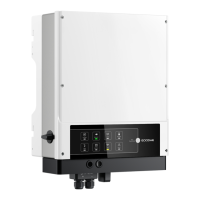4.1 Error Messages
The error messages below will be displayed on the PV Master app or reported by e-mail if an
error occurs.
04 OTHERS
Error Message Explanation Reason Solutions
1. Ensure the inverter's safety country is set correctly.
2. Use a multi-meter to check that the AC voltage (Between L and N) is within the normal range. Repeat this check on the AC breaker side.
a. If the AC voltage is high, make sure the AC cable complies with the requirements stated in the user manual, and is not too long.
b. If the voltage is low, make sure the AC cable is properly connected and the AC cable sleeve is not compressed into the AC terminal.
3. Make sure the grid voltage in your area is stable and within normal range.
1. Use a multi-meter to check whether there is a voltage present on the AC side. Make sure grid power is available.
2. Ensure AC cables are properly and securely connected.
3. If all is well, please turn off the AC breaker and turn it back on after 5 minutes.
1. Use a multi-meter to check whether the resistance between earth and the inverter frame is close to zero. If it is not, please ensure that the
connection is adequate.
2. Excessive humidity can cause isolation failure.
3. Check the resistance between PV1+/PV2+/BAT+/PV- and earth. If the resistance is lower than 33.3k, check the system's wiring connections.
4. Try to restart the inverter. Check whether the fault still occurs. If not, it may have been caused by an intermittent problem. Please contact the
after-sales team for further support.
Public grid power is not available (power
is lost or on-grid connection fails)
Ground leakage current is too high
Utility Loss
VAC Failure
Isolation Failure
Ground Failure
Relay Check Failure
Grid voltage is not within permissible
range
Grid frequency is not within permissible
range
Temperature inside the inverter is too
high
Self-checking for relay failure
Internal communication fails
BUS voltage is over-high
Back-up side is overloaded
Inverter detects that AC voltage exceeds the normal
range required by the safety country.
Inverter cannot detect the connection of grid
Inverter detects that the grid frequency is outside the
normal range required by the safety country.
The inverter's working environment has caused a high
temperature condition
Isolation failure could occur for multiple reasons, such as
poor PV panel grounding, a faulty DC cable, ageing of PV
panels, or comparatively high ambient humidity etc.
Neutral and ground cables are not connected well on the
AC side or just an occasional failure
The inverter detects a higher DC component in the AC output
Caused by a strong external magnetic field etc.
Caused by a strong external magnetic field etc.
Total back-up load power is higher than the back-up
nominal output power
Ground failure could occur for multiple reasons, such as
poor connection of the neutral cable on the AC side, or
comparatively high ambient humidity etc.
/
/
/
DC Injection High
EEPROM R/W Failure
SPI Failure
DC Bus High
Back-Up Overload
FAC Failure
Total DC voltage of the PV string is too
high
The total voltage (short-circuit voltage) of each PV string is
higher than the maximum DC input voltage of the inverter.
PV Over Voltage
Over Temperature
ISO failure could occur for multiple
reasons, such as poor PV panel
grounding, a faulty DC cable, ageing of
PV panels, or comparatively high
ambient humidity etc.
Using a multi-meter, check for a voltage between earth and the inverter frame. This should normally be around 0V. If a voltage is present, it suggests
the neutral and ground cables are not properly connected on the AC side. If this only occurs when air humidity is higher than normal, such as early
morning, at dawn or on rainy days, and only lasts a short time, this is normal behaviour.
Using a multi-meter, check for high voltage high voltage between the N and PE cable on the AC side. This should normally be lower than 10V. If the
voltage is higher than 10V, this suggests the neutral and ground cables are not properly connected on the AC the side. You may need to restart the
inverter.
1. Make sure the inverter's safety country is set correctly.
2. If the safety country is correct, please check the inverter display to ensure the AC frequency (FAC) is within a normal range.
3. If FAC failure only appears a few times and resolves quickly, it may be caused by occasional grid frequency instability.
1. Try to decrease ambient temperature around the inverter.
2. Make sure the installation complies with the instructions in the inverter's user manual.
3. Try to shut down the inverter for 15 mins, then restart it.
Check the PV string VOC is lower than the max PV input voltage of the inverter
If the VOC of the PV string is high, please decrease the number of panels to make sure VOC does not exceed the maximum
DC input voltage of the inverter.
Try to restart the inverter. Check if the fault still occurs. If not, it is just an intermittent condition. Otherwise, contact after-sales support immediately.
Try to restart the inverter. Check if the fault still occurs. If not, it is just an intermittent condition. Otherwise, contact after-sales support immediately.
Try to restart the inverter. Check if the fault still occurs. If not, it is just an intermittent condition. Otherwise, contact after-sales support immediately.
Try to restart the inverter. Check if the fault still occurs. If not, it is just an intermittent condition. Otherwise, contact after-sales support immediately.
Reduce back-up loads to ensure the total load power is less than the nominal back-up output power (please refer to page 11).
24
23

